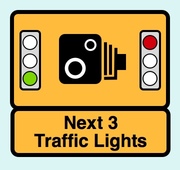
Intersections account for about one third of traffic accidents. Making intersections safer is therefore a high priority when it comes to bringing down the high number of accidents, and targeting particularly dangerous intersections should have particularly high priority. Enter a new tool: speed-on-green cameras. It's actually a tool that is not so new in some jurisdictions. It has been used in Edmonton and other cities in Alberta since 2009. Speed-on-green cameras use the same equipment as red-light cameras, which makes this a very cost-effective tool. During the red phase, the camera catches motorists who don't stop at the red light. During the green phase, the camera catches motorists who go too fast. The objective is to make people stick to the rules of the roads, not to make money with tickets. An important part of making such systems successful is to advise motorists effectively that enforcement is in place. A warning sign like the one on the right above will give motorists ample and highly visible warning that they will get caught speeding or going through a red light. Drive responsibly, or pay!
How well does it work? A November 2010 report The Effectiveness of Speed Cameras: A review of evidence authored by Prof. Richard Allsop, based on research conducted in Great Britain, has a simple but powerful message about the empirical evidence:
The findings are unambiguous. Cameras, historically, have saved lives. They continue to save lives. And should they be removed, speeds will rise and accidents with them.
‘Reducing speed more than proportionately saves lives.’
What the empirical analysis shows is that speed cameras lead to (1) higher compliance with speed limits; (2) a reduction in extreme speeding; and (3) a reduction in average speed at fixed sites. Lower speeds before a collision also allow drivers more time to avoid or mitigate the collision, and lower speeds in a collision lower the force of impact and result in lower severities of injuries. In addition to simply counting accidents, two metrics are widely used to measure the effectiveness of traffic cameras: the number of personal injury collisions (PIC) and the number of those killed or seriously injured (KSI). A widely-quoted meta study by Elvik et al. (2004), updated a few years later, provides an empirical relationship between speed and these two measures. PIC is approximately proportional to the square of average speed, and KSI is approximately proportional to about the cube of average speed. A ten percent reduction in average speed is thus expected to lead to a 19% reduction in PIC and a 27% reduction in KSI. Reducing speed more than proportionally saves lives.
Speeding is one of many problems that contribute to accidents. Distracted driving, and driving under the influence, are others. All of them need to be tackled comprehensively. However, speed is a vicious element in accidents because the laws of physics increase the severity of accidents much more than linearly with speed. This is why PIC and KSI increase with the square and cube of speed, respectively. Reducing speed along with homogenizing speeds (decreasing the speed differential between cars) help reduce accidents. I had commented on the benefits of speed enforcement through section control in 2016, and the use of "speed on green" with ample warning is a natural counterpart for urban areas. Together, these measures can also help fix car insurance in British Columbia, as I described last August.
‘Effective speed control is not a «money grab» but makes motorists obey traffic laws so they don't get fined.’
To be clear: the objective of speed-on-green and red-light cameras is not to make money through issuing tickets, but to avoid issuing tickets in the first place by making motorists stick to the rules of the road. Effective enforcement is about making motorists obey traffic laws and avoid getting tickets, not about generating revenue through issuing fines. Effective speed control is not a «money grab». The real savings come from reduced numbers of accidents. Making monitored intersections highly visible (see the road sign above) is an effective way to zoom in on trouble spots and alert motorists to the higher level of scrutiny. Target the one hundred worst intersections. Often, these intersections are close together (for example, Oak Street and Knight Street in Vancouver). Having sequences of three or more monitored intersections reinforces their effectiveness.
Speed control is no panacea, but it must be part of a comprehensive package of measures. Technological innovation can help, but also needs time to mature. Edmonton had infancy problems with their speed-on-green system. As the CBC reported, in 2001 speeders in Edmonton got $12.3M in refunds when 100,000 tickets were invalidated when a glitch was found in the system. Some also complained about cameras that were too close in proximity, leading to tickets that were issued within 10 seconds of each other. Municipalities will learn from these mistakes and improve design. As a rule of thumb, speed-on-green cameras should be at least 500 meters apart, about five city blocks or about 36 seconds driving at 50 km/h. Other jurisdictions, such as New South Wales in Australia, also offer insights on red-light speed cameras.
Sources and further readings:
- Rune Elvik, Peter Christensen, Astrid Amundsen: Speed and road accidents: An evaluation of the Power Model, Institute of Transport Economics, Norwegian Centre for Transportation Research, 2004
- Rune Elvik: The Power Model of the relationship between speed and road safety: update and new analyses, Institute of Transport Economics, Norwegian Centre for Transportation Research, 2009
- New South Wales Centre for Raod Safety: Speed cameras (includes examples of signage) and NSW Speed Camera Strategy, June 2012.
![[Sauder School of Business]](logo-ubc-sauder-2016.png)
![[The University of British Columbia]](logo-ubc-2016.png)